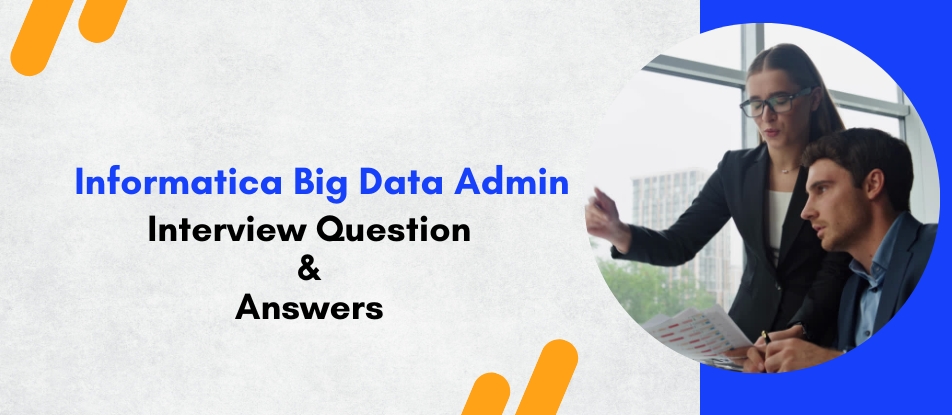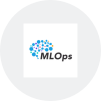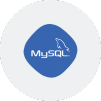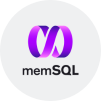
Informatica Big Data Admin Training equips learners with the skills to administer, monitor, and optimize Informatica Big Data Management in distributed environments. The course covers essential topics like engine configuration, job monitoring, pushdown optimization, cluster integration, and troubleshooting. Designed for data administrators and architects, it helps build expertise in managing scalable ETL workflows across Hadoop, Spark, and cloud platforms with a strong focus on performance and security.
Informatica Big Data Admin Training Interview Questions Answers - For Intermediate
1. What is the purpose of the Model Repository Service (MRS) in Informatica BDM?
The Model Repository Service (MRS) manages metadata for all design-time objects such as mappings, workflows, connections, and transformations. It provides version control, supports multi-user collaboration, and ensures consistent project management across development environments.
2. How does Informatica BDM handle schema evolution in big data environments?
BDM supports schema evolution by enabling dynamic schema propagation in mappings. When source or target schemas change (like in Hive), it can adapt using schema drift options, especially when working with Avro or Parquet formats, ensuring data flows continue without manual remapping.
3. What are the common file formats supported by Informatica BDM in Hadoop?
BDM supports a wide range of file formats such as Text, CSV, Avro, Parquet, ORC, JSON, and XML. These formats are commonly used in Hadoop data lakes, and BDM offers connectors and parsers for each to efficiently process large datasets.
4. What is the difference between native and non-native execution modes in Informatica BDM?
Native execution means running mappings using the cluster’s native processing engines like Spark or Hive, while non-native (or Blaze) execution uses Informatica’s Blaze engine. Native modes are optimized for performance but require cluster-specific configurations, whereas Blaze is more portable and easier to set up.
5. How does Informatica BDM enable reusability of components in mappings?
BDM enables reusability through mapplets, parameterized mappings, reusable transformations, and global connections. Developers can build modular components, which reduces redundancy and accelerates development cycles across projects.
6. Explain the concept of Data Object Caching in BDM.
Data Object Caching allows frequently accessed data to be cached locally during transformations. This reduces I/O operations with HDFS or Hive, enhancing performance, especially in lookup or join scenarios with large datasets.
7. How do you tune performance for mappings in Informatica BDM?
Performance tuning in BDM involves using pushdown optimization, proper partitioning, using native file formats like Parquet, avoiding data skew in joins, and configuring memory appropriately. Monitoring cluster resources and optimizing transformation logic also improves efficiency.
8. What role do Hadoop distributions play in Informatica BDM compatibility?
Informatica BDM supports multiple Hadoop distributions like Cloudera, Hortonworks, and MapR. Each distribution may have specific integration methods, security mechanisms, and version dependencies. Admins must ensure compatibility during setup and upgrades.
9. How can you schedule and automate workflows in BDM?
Workflows in BDM can be scheduled using Informatica’s native scheduler or external schedulers like Control-M, Oozie, or cron jobs. Administrators define triggers, dependencies, and execution frequency for automated pipeline orchestration.
10. What is a Developer Tool in Informatica BDM, and what are its key uses?
The Developer Tool is a graphical interface used to design mappings, workflows, and data objects in BDM. It allows drag-and-drop development, metadata browsing, mapplet creation, testing, and debugging, helping both developers and admins visualize data pipelines efficiently.
11. How does Informatica BDM support data lineage and impact analysis?
BDM supports metadata management features like data lineage and impact analysis. It shows how data flows from source to target, including transformations. This aids in audit, compliance, and impact assessments when making schema or logic changes.
12. What is the role of the Informatica Administrator console in BDM?
The Administrator console manages services, monitors jobs, configures security, and allocates resources. It acts as the control center for setting up clusters, domains, node configurations, and overall infrastructure required for smooth BDM operation.
13. How do you handle connection management in Informatica BDM for Hadoop sources?
BDM provides connection objects for Hive, HDFS, HBase, Kafka, and others. Admins configure these by specifying authentication methods, host details, ports, and security settings (Kerberos, SSL, etc.), enabling secure and efficient connectivity.
14. What is partitioning in BDM, and why is it important?
Partitioning breaks down large datasets into smaller chunks for parallel processing. BDM supports source-based, target-based, and transformation-level partitioning. Proper partitioning significantly improves performance in large-scale data workflows.
15. Can Informatica BDM run on the cloud? If yes, how is it managed?
Yes, BDM supports deployment on cloud platforms like AWS, Azure, and GCP. It integrates with cloud-native storage (e.g., S3), Spark clusters, and cloud data warehouses. Admins manage it via the Informatica Intelligent Cloud Services (IICS) platform or through on-prem connectors to cloud data lakes.
Informatica Big Data Admin Training Interview Questions Answers - For Advanced
1. What is dynamic mapping in Informatica BDM, and how is it utilized in a big data context?
Dynamic mapping in Informatica BDM allows for the creation of reusable data pipelines that adapt to varying schemas at runtime. This is particularly useful in big data environments where the structure of incoming data may change frequently, such as IoT feeds, logs, or social media streams. Instead of hardcoding field names and data types, dynamic mappings use parameters and rules to determine source-to-target flows. This reduces development time, minimizes rework, and supports schema evolution without manual intervention. However, developers must ensure proper metadata registration and validation logic to prevent errors when new fields are introduced or types change unexpectedly.
2. How can Informatica BDM be integrated with Apache Kafka for real-time streaming workflows?
Informatica BDM integrates with Kafka through a dedicated Kafka connector that enables ingestion of real-time streaming data. Users can configure Kafka as a source within mappings, allowing BDM to consume messages from specific topics. The integration supports both Avro and JSON message formats, with schema registry compatibility for dynamic decoding. The processed data can then be stored in HDFS, written to Hive, or passed on to downstream systems like NoSQL databases. When used in conjunction with Spark Streaming or Structured Streaming, BDM facilitates near-real-time analytics. Proper checkpointing and offset management must be configured to ensure fault tolerance and message replay in failure scenarios.
3. What is data lineage in BDM and how is it implemented for enterprise governance?
Data lineage in Informatica BDM refers to tracking the complete lifecycle of data from its source through transformations to its final destination. It includes metadata such as field-level changes, applied logic, and data movement paths. Informatica provides tools like Metadata Manager and Enterprise Data Catalog (EDC) that visually represent lineage across systems. This is vital for regulatory compliance, impact analysis, and ensuring data trustworthiness. To implement lineage, admins configure metadata harvesting from systems like Hive, HDFS, Oracle, or Snowflake, enabling cross-platform traceability. Keeping lineage updated with each mapping deployment ensures stakeholders have access to accurate, auditable data flows.
4. Describe a deployment pipeline using Informatica BDM in a DevOps environment.
In a DevOps-enabled environment, Informatica BDM deployment pipelines integrate with CI/CD tools like Jenkins, Azure DevOps, or GitLab. Developers push mapping XMLs and configuration files to a version control repository (e.g., Git). Jenkins is configured to pull changes, validate XML integrity, and trigger deployment using Informatica's infacmd utility. Parameter files, connection overrides, and environment-specific settings are handled via externalized configurations. Testing stages validate output using unit test data, and post-deployment scripts trigger lineage updates and performance benchmarks. Such pipelines ensure consistency, reduce manual errors, and support agile data operations at scale.
5. How do you handle large lookup datasets efficiently in BDM workflows?
Handling large lookup datasets in BDM requires careful optimization to avoid memory overhead and performance bottlenecks. One approach is to use persistent or uncached lookups, especially when the lookup data is dynamic or exceeds available memory. Partitioning both source and lookup datasets by the join key enhances parallelism. In Spark execution mode, broadcast joins are used for small lookup datasets, whereas map-side joins suit larger datasets. Additionally, pushing lookup logic to Hive through pushdown optimization helps leverage big data engines for distributed processing. Using indexed Hive tables or materialized views for lookups can also enhance performance.
6. What is the role of Informatica’s Metadata Manager in large-scale data governance?
Informatica’s Metadata Manager centralizes the management of metadata across the enterprise. It plays a critical role in data governance by cataloging data assets, tracking their lineage, managing impact analysis, and defining business glossaries. In BDM contexts, it connects to Hadoop, cloud platforms, relational databases, and ERP systems to provide a unified metadata repository. It helps data stewards ensure data quality, compliance, and traceability. Integration with role-based access control ensures that only authorized users can modify or view sensitive metadata. Automated metadata harvesting and periodic synchronization maintain consistency across rapidly changing environments.
7. What are some advanced tuning techniques for Spark jobs executed via Informatica BDM?
Tuning Spark jobs in BDM involves optimizing executor memory, core allocation, shuffle behavior, and caching. Advanced techniques include adjusting the number of shuffle partitions, enabling Kryo serialization for efficient memory use, and reusing RDDs via caching. Monitoring Spark UI helps identify stage-level bottlenecks and long-running tasks. Enabling dynamic allocation lets Spark adapt resources based on workload. Developers should minimize wide transformations (like groupBy) and leverage mapPartitions where possible. Additionally, filtering data early and avoiding collect operations on large datasets reduces strain on the driver and improves job stability.
8. Explain how BDM handles file-based ingestion in distributed HDFS systems.
BDM supports ingesting data from HDFS using native connectors and physical data objects (PDOs). Files can be in various formats like CSV, JSON, Avro, Parquet, and ORC. During ingestion, developers can apply schema-on-read logic to interpret data dynamically. Parallel reads are supported for partitioned files, and filtering can be applied using predicates to reduce read scope. File monitoring features allow automatic ingestion upon new file arrivals. For performance, using splittable file formats (like Parquet) allows BDM to distribute read operations across cluster nodes efficiently. Admins must also manage file-level permissions and ensure schema consistency to avoid job failures.
9. How is error handling and exception logging implemented in BDM for Spark-based jobs?
In BDM, error handling can be configured at transformation, mapping, and session levels. For Spark-based jobs, failed records can be routed to rejection paths using the Update Strategy or Filter transformations. Detailed error messages are captured in the session log, accessible via the Administrator console or Spark UI. Users can enable verbose logging and structured error output for downstream troubleshooting. Exception handling routines include retry logic, error thresholds, and email notifications. Logging best practices include using centralized logging systems such as Splunk or ELK stack for analysis and audit compliance.
10. What is the impact of schema drift in BDM, and how do you design to accommodate it?
Schema drift refers to the phenomenon where the structure of incoming data changes over time. In BDM, this can break mappings if not handled proactively. To accommodate schema drift, mappings can use dynamic ports or hierarchical schema definitions that adjust to new fields. Using schema evolution support in formats like Avro and Parquet also helps. Developers can create mappings that rely on metadata introspection or define optional fields with default values. Designing robust validation and alerting mechanisms ensures teams are notified when significant schema changes occur, preventing silent data corruption or mapping failures.
11. Describe how Informatica BDM supports multi-tenant architecture in shared environments.
In multi-tenant architectures, multiple business units or clients share infrastructure while maintaining data and process isolation. BDM supports this via role-based access, domain segmentation, and repository partitioning. Admins can configure separate folders, connections, and parameter sets for each tenant. Integration Service configurations and execution environments can be tenant-specific, and data masking ensures sensitive data remains private. Audit logs and metadata access policies are tenant-aware, allowing centralized governance without breaching tenant boundaries. This approach ensures cost-effective infrastructure usage while maintaining strong data security and operational independence.
12. How do you troubleshoot a mapping that works in Blaze but fails in Spark within BDM?
To troubleshoot discrepancies between Blaze and Spark execution, first compare the mapping logic against known transformation limitations in Spark. Blaze may support features like certain Java-based expressions or specific transformation chaining that Spark does not. Reviewing the Spark job logs and execution plan in the Spark UI reveals where the failure occurs—common issues include null handling, unsupported data types, or resource exhaustion. Differences in temporary file storage and cluster resource allocations may also cause job divergence. Rewriting incompatible transformations, validating schema, and testing step-by-step execution often resolve such issues.
13. What are the compliance considerations when using BDM in industries like finance or healthcare?
Compliance in regulated industries involves adhering to standards like HIPAA, GDPR, and SOX. BDM supports compliance by offering secure data masking, field-level lineage, audit logging, and role-based access controls. Administrators can configure fine-grained access for PII fields, enforce encryption at rest and in transit, and ensure audit trails are immutable. Automated lineage reporting supports audit readiness, while masking and tokenization tools help ensure only authorized views of sensitive data. Periodic governance reviews and integration with data classification tools enhance adherence to regulatory requirements.
14. Explain the role of session parameters and parameter sets in advanced BDM deployment strategies.
Session parameters and parameter sets in BDM enable mappings to be flexible and environment-independent. They allow values such as file paths, connection details, filter conditions, or date ranges to be configured externally. Parameterization is key in automated deployments where the same mapping is executed across dev, QA, and production environments. Parameter files (.pm files) or mapping parameter sets stored in the repository ensure consistent behavior without code changes. This strategy also supports reusability and modular deployment in CI/CD pipelines, enabling smoother DevOps processes.
15. How do you scale Informatica BDM deployments to handle petabyte-scale data workloads?
Scaling BDM for petabyte-scale data involves optimizing both the platform and the process. This includes deploying on powerful clusters with scalable storage like HDFS or S3, configuring YARN or Kubernetes for elastic resource allocation, and using Spark for distributed in-memory execution. Workflows are designed to process data incrementally or in micro-batches to avoid monolithic job failures. Partitioning, compression, and columnar formats are used to reduce I/O. Parameterization, job chaining, and resource pooling help manage concurrency. Additionally, observability via dashboards and alerts ensures proactive issue resolution and sustained performance at scale.
Course Schedule
| Dec, 2025 | Weekdays | Mon-Fri | Enquire Now |
| Weekend | Sat-Sun | Enquire Now | |
| Jan, 2026 | Weekdays | Mon-Fri | Enquire Now |
| Weekend | Sat-Sun | Enquire Now |
Related Courses
Related Articles
Related Interview
Related FAQ's
- Instructor-led Live Online Interactive Training
- Project Based Customized Learning
- Fast Track Training Program
- Self-paced learning
- In one-on-one training, you have the flexibility to choose the days, timings, and duration according to your preferences.
- We create a personalized training calendar based on your chosen schedule.
- Complete Live Online Interactive Training of the Course
- After Training Recorded Videos
- Session-wise Learning Material and notes for lifetime
- Practical & Assignments exercises
- Global Course Completion Certificate
- 24x7 after Training Support














 Join our Live Instructor-Led online classes delivered by industry experts
Join our Live Instructor-Led online classes delivered by industry experts